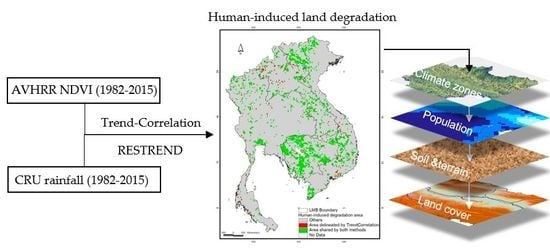Assessment of the Biomass Productivity Decline in the Lower Mekong Basin
Abstract
1. Introduction
2. Materials and Methods
2.1. Study Area
2.2. Datasets and Data Processing
2.3. Methods
2.3.1. Proxy for Long-Term Biomass Productivity Decline at the Lower Mekong Basin Region
2.3.2. Pixel-Based Temporal Trend of Biomass Productivity
2.3.3. Isolation of Rainfall Impacts
2.3.4. Relational Analyses of Potential Underlying Processes
3. Results
3.1. Proxy for Long-Term Biomass Productivity Decline
3.2. Temporal Trend of Biomass Productivity
3.3. Isolation of Rainfall Variation Effect
3.4. Relational Analyses of Potential Underlying Processes
3.4.1. Climate Zones
3.4.2. Land Degradation in Relation to Population Density
3.4.3. Land Degradation in Relation to Soil and Terrain Constraints and Population Densities
3.4.4. Land Cover and Land Degradation Processes
4. Discussion
4.1. New Methods
4.2. Contextualization of the Empirical Findings
4.3. Limitations and Lesson Learned
5. Conclusions
Supplementary Materials
Author Contributions
Funding
Acknowledgments
Conflicts of Interest
References
- Lal, R.; Safriel, U.; Boer, B. Zero Net Land Degradation: A New Sustainable Development Goal for Rio + 20. Secretariat of the United Nations Convention to Combat Desertification (UNCCD): 2012. pp. 1–30. Available online: http://www.unccd.int/Lists/SiteDocumentLibrary/secretariat/2012/Zero%2020Net%2020Land%2020Degradation%2020Report%2020UNCCD%2020May%202012%202020background.pdf (accessed on 20 August 2013).
- Von Braun, J.; Gerber, N. The Economics of Land and Soil Degradation-Toward an Assessment of the Costs of Inaction. In Recarbonization of the Biosphere; Lal, R., Lorenz, K., Hüttl, R.F., Schneider, B.U., von Braun, J., Eds.; Springer: Dordrecht, The Netherlands, 2012; pp. 493–516. [Google Scholar] [CrossRef]
- Eswaran, H.; Lal, R.; Reich, P.F. Land Degradation: An overview. In Proceedings of the 2nd International Conference on Land Degradation and Desertification, Khon Kaen, Thailand, 25–29 January 1999; Oxford Press, 2001. [Google Scholar]
- Dregne, H.E.; Chou, N.-T. Global desertification dimensions and costs. In Degradation and Restoration of Arid Lands; Texas Tech University: Lubbock, TX, USA, 1992. [Google Scholar]
- Gibbs, H.K.; Salmon, J.M. Mapping the world’s degraded lands. Appl. Geogr. 2015, 57, 12–21. [Google Scholar] [CrossRef]
- Nkonya, E.; Anderson, W.; Kato, E.; Koo, J.; Mirzabaev, A.; von Braun, J.; Meyer, S. Global Cost of Land Degradation. In Economics of Land Degradation and Improvement—A Global Assessment for Sustainable Development; Nkonya, E., Mirzabaev, A., von Braun, J., Eds.; Springer: Cham, Switzerland, 2016; pp. 117–165. [Google Scholar] [CrossRef]
- Safriel, U.N. The assessment of global trends in land degradation. In Climate and Land Degradation; Sivakumar, M.V.K., Ndiang’ui, N., Eds.; Springer: Berlin/Heidelberg, Germany, 2007; pp. 1–38. [Google Scholar] [CrossRef]
- UNEP. Global Environment Outlook 4; United Nations Environment Programme: Nairobi, Kenya, 2007; Available online: http://www.unep.org/geo/geo4.asp (accessed on 12 August 2017).
- GEF. Land Degradation as a Global Environmental Issue: A Synthesis of Three Studies Commissioned by the Global Environment Facility to Strengthen the Knowledge Base to Support the Land Degradation Focal Area; Global Environment Facility: Washington, DC, USA, 2006. [Google Scholar]
- Jansa, J.; Frossard, E.; Stamp, P.; Kreuzer, M.; Scholz, R.W. Future Food Production as Interplay of Natural Resources, Technology, and Human Society. J. Ind. Ecol. 2010, 14, 874–877. [Google Scholar] [CrossRef]
- FAO. Global Forest Resources Assessment 2010, Main Report; FAO: Rome, Italy, 2010. [Google Scholar]
- Vlek, P.L.G.; Le, Q.B.; Tamene, L. Assessment of land degradation, its possible causes and threat to food security in sub-Saharan Africa. In Food Security and Soil Quality; Lal, R.A.S., Stewart, B.A., Eds.; Taylor and Francis: Abingdon, UK, 2010; p. 430. [Google Scholar]
- Vu, Q.M.; Le, Q.B.; Frossard, E.; Vlek, P.L.G. Socio-economic and biophysical determinants of land degradation in Vietnam: An integrated causal analysis at the national level. Land Use Policy 2014, 36, 605–617. [Google Scholar] [CrossRef]
- Vu, Q.M.; Le, Q.B.; Vlek, P.L.G. Hotspots of human-induced biomass productivity decline and their social–ecological types toward supporting national policy and local studies on combating land degradation. Glob. Planet. Chang. 2014, 121, 64–77. [Google Scholar] [CrossRef]
- Behrend, H. Land Degradation and Its Impact on Security. In Land Restoration; Chabay, I., Frick, M., Helgeson, J., Eds.; Academic Press: Boston, MA, USA, 2016; pp. 13–26. [Google Scholar] [CrossRef]
- Stocking, M.A. Land Degradation. In International Encyclopedia of the Social & Behavioral Sciences; Smelser, N.J., Baltes, P.B., Eds.; Pergamon: Oxford, UK, 2001; pp. 8242–8247. [Google Scholar] [CrossRef]
- Prince, S.; Von Maltitz, G.; Zhang, F.; Byrne, K.; Driscoll, C.; Eshel, G.; Kust, G.; Martínez-Garza, C.; Metzger, J.P.; Midgley, G.; et al. Status and trends of land degradation and restoration and associated changes in biodiversity and ecosystem fundtions. In IPBES (2018): The IPBES Assessment Report on Land Degradation and Restoration; Montanarella, L., Scholes, R., Brainich, A., Eds.; Secretariat of the Intergovernmental Science-Policy Platform on Biodiversity and Ecosystem Services: Bonn, Germany, 2018; pp. 221–338. [Google Scholar]
- Geist, H.J.; Lambin, E.F. Dynamic causal patterns of desertification. BioScience 2004, 54, 817–829. [Google Scholar] [CrossRef]
- Nkonya, E.; Gerber, N.; Baumgartner, P.; von Braun, J.; De Pinto, A.; Graw, V.; Kato, E.; Kloos, J.; Walter, T. The Economics of Land Degradation: Toward an Integrated Global Assessment; Peter Lang: Frankfurt, Germany, 2011; p. 262. [Google Scholar]
- Geist, H.; Lambin, E. Proximate causes and underlying driving forces of tropical deforestation. BioScience 2002, 52, 143–150. [Google Scholar] [CrossRef]
- Stocking, M.; Murnaghan, N. Handbook for the Field Assessment of Land Degradation; Earthscan Publications: London, UK, 2001; p. 169. [Google Scholar]
- Foley, J.A.; Ramankutty, N.; Brauman, K.A.; Cassidy, E.S.; Gerber, J.S.; Johnston, M.; Mueller, N.D.; O’Connell, C.; Ray, D.K.; West, P.C.; et al. Solutions for a cultivated planet. Nature 2011, 478, 337–342. [Google Scholar] [CrossRef]
- Rossi, C.G.; Srinivasan, R.; Jirayoot, K.; Duc, T.L.; Souvannabouth, P.; Binh, N.; Gassman, P.W. Hydrologic evaluation of the lower Mekong River Basin with the soil and water assessment tool model. Int. Agric. Eng. J. 2009, 18, 1–13. [Google Scholar]
- WB. World Bank Open Data, Vietnam country. Available online: http://data.worldbank.org (accessed on 12 May 2018).
- WWF. Mekong River in the Economy; WWF Greater Mekong: Bangkok, Thailand, 2016. [Google Scholar]
- Chea, R.; Grenouillet, G.; Lek, S. Evidence of Water Quality Degradation in Lower Mekong Basin Revealed by Self-Organizing Map. PLoS ONE 2016, 11, e0145527. [Google Scholar] [CrossRef]
- Costenbader, J.; Varns, T.; Vidal, A.; Stanley, L.; Broadhead, J. Drivers of Deforestation in the Greater Mekong Subregion Regional Report; USAID Lowering Emissions in Asia’s Forests (USAID LEAF): Bangkok, Thailand, 2015. [Google Scholar]
- UNEP. Environmental Indicators South East Asia; United Nations Environment Programme; Regional Resource Centre for Asia and the Pacific: Pathum Thani, Thailand, 2004. [Google Scholar]
- Van Lynden, G.W.J.; Oldeman, L.R. Assessment of the Status of Human-induced soil degradation in South and South East Asia; International Soil Reference and Information Centre: Wageningen, The Netherlands, 1997; p. 35. Available online: http://lime.isric.nl/Docs/ASSODEndReport.pdf (accessed on 17 July 2014).
- Prince, S.D. Where Does Desertification Occur? Mapping Dryland Degradation at Regional to Global Scales. In The End of Desertification? Disputing Environmental Change in the Drylands; Behnke, R., Mortimore, M., Eds.; Springer: Berlin/Heidelberg, Germany, 2016; pp. 225–263. [Google Scholar] [CrossRef]
- Sonneveld, B.G.J.S.; Dent, D.L. How good is GLASOD? J. Environ. Manag. 2009, 90, 274–283. [Google Scholar] [CrossRef]
- Vogt, J.V.; Safriel, U.; Von Maltitz, G.; Sokona, Y.; Zougmore, R.; Bastin, G.; Hill, J. Monitoring and assessment of land degradation and desertification: Towards new conceptual and integrated approaches. Land Degrad. Dev. 2011, 22, 150–165. [Google Scholar] [CrossRef]
- Shrestha, R.P.; Roy, K. Land degradation assessment in the Greater Mekong Sub-region. J. Environ. Inf. Sci. 2008, 35, 29–38. [Google Scholar]
- Le, Q.B.; Tamene, L.; Vlek, P.L.G. Multi-pronged assessment of land degradation in West Africa to assess the importance of atmospheric fertilization in masking the processes involved. Glob. Planet. Chang. 2012, 92, 71–81. [Google Scholar] [CrossRef]
- Bai, Z.G.; Dent, D.L.; Olsson, L.; Schaepman, M.E. Proxy global assessment of land degradation. Soil Use Manag. 2008, 24, 223–234. [Google Scholar] [CrossRef]
- Symeonakis, E.; Drake, N. Monitoring desertification and land degradation over sub-Saharan Africa. Int. J. Remote Sens. 2004, 25, 573–592. [Google Scholar] [CrossRef]
- Anyamba, A.; Tucker, C. Historical perspectives on AVHRR NDVI and vegetation drought monitoring. Remote Sens. Drought Innov. Monit. Approaches 2012. [Google Scholar] [CrossRef]
- Cook, B.; Pau, S. A Global Assessment of Long-Term Greening and Browning Trends in Pasture Lands Using the GIMMS LAI3g Dataset. Remote Sens. 2013, 5, 2492–2512. [Google Scholar] [CrossRef]
- D’Odorico, P.; Ravi, S. Chapter 11 - Land Degradation and Environmental Change. In Biological and Environmental Hazards, Risks, and Disasters; Shroder, J.F., Sivanpillai, R., Eds.; Academic Press: Boston, MA, USA, 2016; pp. 219–227. [Google Scholar] [CrossRef]
- Fensholt, R.; Langanke, T.; Rasmussen, K.; Reenberg, A.; Prince, S.D.; Tucker, C.; Scholes, R.J.; Le, Q.B.; Bondeau, A.; Eastman, R.; et al. Greenness in semi-arid areas across the globe 1981–2007—An Earth Observing Satellite based analysis of trends and drivers. Remote Sens. Environ. 2012, 121, 144–158. [Google Scholar] [CrossRef]
- Xu, C.; Li, Y.; Hu, J.; Yang, X.; Sheng, S.; Liu, M. Evaluating the difference between the normalized difference vegetation index and net primary productivity as the indicators of vegetation vigor assessment at landscape scale. Environ. Monit. Assess. 2012, 184, 1275–1286. [Google Scholar] [CrossRef]
- Wessels, K.J.; Prince, S.D.; Malherbe, J.; Small, J.; Frost, P.E.; VanZyl, D. Can human-induced land degradation be distinguished from the effects of rainfall variability? A case study in South Africa. J. Arid Environ. 2007, 68, 271–297. [Google Scholar] [CrossRef]
- Fensholt, R.; Rasmussen, K. Analysis of trends in the Sahelian rain-use efficiency’ using GIMMS NDVI, RFE and GPCP rainfall data. Remote Sens. Environ. 2011, 115, 438–451. [Google Scholar] [CrossRef]
- Holm, A.M.; Cridland, S.W.; Roderick, M.L. The use of time-integrated NOAA NDVI data and rainfall to assess landscape degradation in the arid shrubland of Western Australia. Remote Sens. Environ. 2003, 85, 145–158. [Google Scholar] [CrossRef]
- Evans, J.; Geerken, R. Discrimination between climate and human-induced dryland degradation. J. Arid Environ. 2004, 57, 535–554. [Google Scholar] [CrossRef]
- Le, Q.B.; Nkonya, E.; Mirzabaev, A. Biomass Productivity-Based Mapping of Global Land Degradation Hotspots. In Economics of Land Degradation and Improvement—A Global Assessment for Sustainable Development; Nkonya, E., Mirzabaev, A., von Braun, J., Eds.; Springer: Cham, Switzerland, 2016; pp. 55–84. [Google Scholar] [CrossRef]
- Tucker, C.J. Red and photographic infrared linear combinations for monitoring vegetation. Remote Sens. Environ. 1979, 8, 127–150. [Google Scholar] [CrossRef]
- Tucker, C.J.; Vanpraet, C.; Boerwinkel, E.; Gaston, A. Satellite remote sensing of total dry matter production in the Senegalese Sahel. Remote Sens. Environ. 1983, 13, 461–474. [Google Scholar] [CrossRef]
- Tucker, C.J.; Sellers, P.J. Satellite remote sensing of primary production. Int. J. Remote Sens. 1986, 7, 1395–1416. [Google Scholar] [CrossRef]
- Ibrahim, Z.Y.; Balzter, H.; Kaduk, J.; Tucker, J.C. Land Degradation Assessment Using Residual Trend Analysis of GIMMS NDVI3g, Soil Moisture and Rainfall in Sub-Saharan West Africa from 1982 to 2012. Remote Sens. 2015, 7. [Google Scholar] [CrossRef]
- Gichenje, H.; Godinho, S. Establishing a land degradation neutrality national baseline through trend analysis of GIMMS NDVI Time-series. Land Degrad. Dev. 2018, 29, 2985–2997. [Google Scholar] [CrossRef]
- Gouveia, C.M.; Páscoa, P.; Russo, A.; Trigo, R.M. Land degradation trend assessment over Iberia during 1982–2012. Cuad. Investig. Geogr. 2016, 42. [Google Scholar] [CrossRef]
- Bai, Z.; Dent, D.L. Global Assessment of Land Degradation and Improvement Pilot Kenya; ISRIC—World Soil Information: Wageningen, The Netherlands, 2006. [Google Scholar]
- Bai, Z.G.; Dent, D.L.; Olsson, L.; Schaepman, M.E. Global Assessment of Land Degradation and Improvement 1; Identification by Remote Sensing; ISRIC—World Soil Information, Food and Agriculture Organization of The United Nations: Wageningen, The Netherlands, 2008. [Google Scholar]
- Li, Z.; Deng, X.; Yin, F.; Yang, C. Analysis of Climate and Land Use Changes Impacts on Land Degradation in the North China Plain. Adv. Meteorol. 2015, 2015, 11. [Google Scholar] [CrossRef]
- Weltzin, J.F.; Tissue, D.T. Resource pulses in arid environments—Patterns of rain, patterns of life. New Phytol. 2003, 157, 171–173. [Google Scholar] [CrossRef]
- Huxman, T.E.; Smith, M.D.; Fay, P.A.; Knapp, A.K.; Shaw, M.R.; Loik, M.E.; Smith, S.D.; Tissue, D.T.; Zak, J.C.; Weltzin, J.F.; et al. Convergence across biomes to a common rain-use efficiency. Nature 2004, 429, 651–654. [Google Scholar] [CrossRef] [PubMed]
- Eisfelder, C.; Klein, I.; Niklaus, M.; Kuenzer, C. Net primary productivity in Kazakhstan, its spatio-temporal patterns and relation to meteorological variables. J. Arid Environ. 2014, 103, 17–30. [Google Scholar] [CrossRef]
- Prince, S.D.; De Colstoun, E.B.; Kravitz, L.L. Evidence from rain-use efficiencies does not indicate extensive Sahelian desertification. Glob. Chang. Biol. 1998, 4, 359–374. [Google Scholar] [CrossRef]
- Herrmann, S.M.; Anyamba, A.; Tucker, C.J. Recent trends in vegetation dynamics in the African Sahel and their relationship to climate. Glob. Environ. Chang. Part A 2005, 15, 394–404. [Google Scholar] [CrossRef]
- Archer, E.R.M. Beyond the climate versus grazing impasse: Using remote sensing to investigate the effects of grazing system choice on vegetation cover in the eastern Karoo. J. Arid Environ. 2004, 57, 381–408. [Google Scholar] [CrossRef]
- Apaydin, H.; Anli, A.S.; Ozturk, F. Evaluation of topographical and geographical effects on some climatic parameters in the Central Anatolia Region of Turkey. Int. J. Climatol. 2011, 31, 1264–1279. [Google Scholar] [CrossRef]
- Meehl, G.A. Effect of Tropical Topography on Global Climate. Annu. Rev. Earth Planet. Sci. 1992, 20, 85–112. [Google Scholar] [CrossRef]
- Ogwang, B.A.; Chen, H.; Li, X.; Gao, C. The Influence of Topography on East African October to December Climate: Sensitivity Experiments with RegCM4. Adv. Meteorol. 2014, 2014, 14. [Google Scholar] [CrossRef]
- Adams, H.R.; Barnard, H.R.; Loomis, A.K. Topography alters tree growth–climate relationships in a semi-arid forested catchment. Ecosphere 2014, 5, art148. [Google Scholar] [CrossRef]
- Zhang, S.; Zhang, X.; Huffman, T.; Liu, X.; Yang, J. Influence of topography and land management on soil nutrients variability in Northeast China. Nutr. Cycl. Agroecosystems 2011, 89, 427–438. [Google Scholar] [CrossRef]
- Florinsky, I.; Eilers, R.G.; Manning, G.R.; Fuller, L.G. Prediction of Soil Properties by Digital Terrain Modeling; Elsevier: Amsterdam, The Netherlands, 2002; pp. 295–311. [Google Scholar]
- Ceddia, M.B.; Vieira, S.R.; Villela, A.L.O.; Mota, L.d.S.; Anjos, L.H.C.d.; Carvalho, D.F.D. Topography and spatial variability of soil physical properties. Sci. Agric. 2009, 66, 338–352. [Google Scholar] [CrossRef]
- Park, S.J.; McSweeney, K.; Lowery, B. Identification of the spatial distribution of soils using a process-based terrain characterization. Geoderma 2001, 103, 249–272. [Google Scholar] [CrossRef]
- Florinsky, I.V.; Kuryakova, G.A. Influence of topography on some vegetation cover properties. Catena 1996, 27, 123–141. [Google Scholar] [CrossRef]
- Bunyan, M.; Bardhan, S.; Singh, A.; Jose, S. Effect of topography on the distribution of tropical montane forest fragments: A predictive modelling approach. J. Trop. For. Sci. 2015, 27, 30–38. [Google Scholar]
- Pinzon, E.J.; Tucker, J.C. A Non-Stationary 1981–2012 AVHRR NDVI3g Time Series. Remote Sens. 2014, 6. [Google Scholar] [CrossRef]
- Didan, K. MOD13A3 MODIS/Terra vegetation Indices Monthly L3 Global 1km SIN Grid V006. NASA EOSDIS Land Process. DAAC 2015. [Google Scholar] [CrossRef]
- Daac, N.L. Terra/MODIS Net Primary Production Yearly L4 Global 1km; NASA EOSDIS Land Processes DAAC: Falls, SD, USA, 2015. [Google Scholar]
- Harris, I.; Jones, P.D.; Osborn, T.J.; Lister, D.H. Updated high-resolution grids of monthly climatic observations—The CRU TS3.10 Dataset. Int. J. Climatol. 2014, 34, 623–642. [Google Scholar] [CrossRef]
- Peel, M.C.; Finlayson, B.L.; McMahon, T.A. Updated world map of the Köppen-Geiger climate classification. Hydrol. Earth Syst. Sci. 2007, 11, 1633–1644. [Google Scholar] [CrossRef]
- Center for International Earth Science Information Network, C.C.U. Gridded Population of the World, Version 4 (GPWv4): Population Density, Revision 10; NASA Socioeconomic Data and Applications Center (SEDAC): Palisades, NY, USA, 2017; Available online: http://sedac.ciesin.columbia.edu/data/set/gpw-v4-population-count/data-download (accessed on 15 August 2017).
- Jarvis, A.; Reuter, H.I.; Nelson, A.; Guevara, E. Hole-Filled SRTM for the Globe Version 4, Available from the CGIAR-CSI SRTM 90m Database. 2008. Available online: http://srtm.csi.cgiar.org (accessed on 5 May 2018).
- Reuter, H.I.; Nelson, A.; Jarvis, A. An evaluation of void-filling interpolation methods for SRTM data. Int. J. Geogr. Inf. Sci. 2007, 21, 983–1008. [Google Scholar] [CrossRef]
- Fischer, G.; van Velthuizen, H.T.; Shah, M.; Nachtergaele, F.O. Global Agro-Ecological Assessment for Agriculture in the 21st Century: Methodology and Results; International Institute for Applied Systems Analysis (IIASA) and Food and Agriculture Organization of the United Nations (FAO): Laxenburg, Austria, 2002. [Google Scholar]
- Lloyd, C.T.; Sorichetta, A.; Tatem, A.J. High resolution global gridded data for use in population studies. Sci. Data 2017, 4, 170001. [Google Scholar] [CrossRef] [PubMed]
- Helldén, U.; Tottrup, C. Regional desertification: A global synthesis. Glob. Planet. Chang. 2008, 64, 169–176. [Google Scholar] [CrossRef]
- De Jong, R.; de Bruin, S.; de Wit, A.; Schaepman, M.E.; Dent, D.L. Analysis of monotonic greening and browning trends from global NDVI time-series. Remote Sensing of Environment 2011, 115, 692–702. [Google Scholar] [CrossRef]
- De Jong, R.; Verbesselt, J.; Schaepman, M.E.; de Bruin, S. Trend changes in global greening and browning: contribution of short-term trends to longer-term change. Global Change Biology 2012, 18, 642–655. [Google Scholar] [CrossRef]
- Yengoh, G.T.; Dent, D.; Olsson, L.; Tengberg, A.E.; Tucker, C.J. Use of the Normalized Difference Vegetation Index (NDVI) to Assess. Land Degradation at Multiple Scales: Current Status, Future Trends, and Practical Considerations; Springer: Berlin/Heidelberg, Germany, 2015; p. 110. [Google Scholar] [CrossRef]
- Kundu, A.; Patel, N.R.; Saha, S.K.; Dutta, D. Desertification in western Rajasthan (India): An assessment using remote sensing derived rain-use efficiency and residual trend methods. Nat. Hazards 2017, 86, 297–313. [Google Scholar] [CrossRef]
- Rishmawi, K.; Prince, S. Environmental and Anthropogenic Degradation of Vegetation in the Sahel from 1982 to 2006. Remote Sens. 2016, 8, 948. [Google Scholar] [CrossRef]
- Prince, S.D.; Goward, S.N. Global Primary Production: A Remote Sensing Approach. J. Biogeogr. 1995, 22, 815–835. [Google Scholar] [CrossRef]
- Field, C.B.; Randerson, J.T.; Malmström, C.M. Global net primary production: Combining ecology and remote sensing. Remote Sens. Environ. 1995, 51, 74–88. [Google Scholar] [CrossRef]
- Wessels, K.J. Letter to the Editor—Comments on ‘Proxy global assessment of land degradation’ by Bai et al., (2008). Soil Use Manag. 2009, 25, 91–92. [Google Scholar] [CrossRef]
- Brown, M.E.; Pinzon, J.E.; Didan, K.; Morisette, J.T.; Tucker, C.J. Evaluation of the consistency of long-term NDVI time series derived from AVHRR, SPOT-Vegetation, SeaWIFS, MODIS and LandSAT ETM+. IEEE Trans. Geosci. Remote Sens. 2006, 44, 1787–1793. [Google Scholar] [CrossRef]
- Tarnavsky, E.; Garrigues, S.; Brown, M.E. Multiscale geostatistical analysis of AVHRR, SPOT-VGT, and MODIS global NDVI products. Remote Sens. Environ. 2008, 112, 535–549. [Google Scholar] [CrossRef]
- Gallo, K.; Ji, L.; Reed, B.; Eidenshink, J.; Dwyer, J. Multi-platform comparisons of MODIS and AVHRR normalized difference vegetation index data. Remote Sens. Environ. 2005, 99, 221–231. [Google Scholar] [CrossRef]
- Tucker, C.J.; Pinzon, J.E.; Brown, M.E.; Slayback, D.A.; Pak, E.W.; Mahoney, R.; Vermote, E.F.; El Saleous, N. An extended AVHRR 8km NDVI dataset compatible with MODIS and SPOT vegetation NDVI data. Int. J. Remote Sens. 2005, 26, 4485–4498. [Google Scholar] [CrossRef]
- Du, J.Q.; Shu, J.M.; Wang, Y.H.; Li, Y.C.; Zhang, L.B.; Guo, Y. Comparison of GIMMS and MODIS normalized vegetation index composite data for Qing-Hai-Tibet Plateau. J. Appl. Ecol. 2014, 2, 533–544. [Google Scholar]
- Fensholt, R.; Proud, S.R. Evaluation of Earth Observation based global long term vegetation trends—Comparing GIMMS and MODIS global NDVI time series. Remote Sens. Environ. 2012, 119, 131–147. [Google Scholar] [CrossRef]
- Scholz, R.W.; Tietje, O. Embedded Case Study Methods: Integrating Quantitative and Qualitative Knowledge; Sage Publications: Thousand Oaks, CA, USA, 2002. [Google Scholar]
- NAP. National Action Programme to Combat Desertification for the Period. 2006–2010 and Orientation to 2020; NAP: Hanoi, Vietnam, 2006. [Google Scholar]
- WWF. Pulse of the Forest; World Wildlife Fund: Gland, Switzerland, 2018. [Google Scholar]
- Trend, F. Conversion Timber, Forest Monitoring, and Land-Use Governance in Cambodia; Forest Trend: Washington, DC, USA, 2015. [Google Scholar]
- Slayback, D.; Sunderland, T.C.H. Forest degradation in the Lower Mekong and an assessment of protected area effectiveness c1990–c2009: A satellite perspective. In Evidence-Based Conservation: Lessons from the Lower Mekong; Sunderland, T.C.H., Sayer, J.A., Hoang, M.H., Eds.; Earthscan: London, UK, 2013; pp. 332–350. [Google Scholar]
- ICEM. USAID Mekong ARCC Climate Change Impact and Adaptation Study for the Lower Mekong Basin: Main Report; Prepared for the United States Agency for International Development by ICEM—International Centre for Environmental Management: Bangkok, Thailand, 2013. [Google Scholar]
- Thanh, N.C.; Singh, B. Trend in rice production and export in Vietnam. Omonrice J. 2006, 14, 111–123. [Google Scholar]
- Linh, V.H. Efficiency of rice farming households in Vietnam. Int. J. Dev. Issues 2012, 11, 60–73. [Google Scholar] [CrossRef]
- LeCoq, J.F.; Dufumier, M.; Trébuil, G. History of rice production in the Mekong Delta. In Proceedings of the 3rd Euroseas Conference, London, UK, 6–8 September 2001. [Google Scholar]
- Somporn, I.; Isriya, B. Food Security in Thailand: Status, Rural Poor Vulnerability, and Some Policy Options; Kasetsart University, Department of Agricultural and Resource Economics: Bangkok, Thailand, 2009. [Google Scholar]
- Vo, T.Q.; Oppelt, N.; Leinenkugel, P.; Kuenzer, C. Remote Sensing in Mapping Mangrove Ecosystems—An Object-Based Approach. Remote Sens. 2013, 5. [Google Scholar] [CrossRef]
- Kovacs, J.M.; Flores-Verdugo, F.; Wang, J.; Aspden, L.P. Estimating leaf area index of a degraded mangrove forest using high spatial resolution satellite data. Aquat. Bot. 2004, 80, 13–22. [Google Scholar] [CrossRef]
- Richards, D.R.; Friess, D.A. Rates and drivers of mangrove deforestation in Southeast Asia, 2000–2012. Proc. Natl. Acad. Sci. USA 2016, 113, 344–349. [Google Scholar] [CrossRef]
- Lebel, L.; Tri, N.H.; Saengnoree, A.; Pasong, S.; Buatama, U.; Thoa, L.T.K. Industrial transformation and shrimp aquaculture in Thailand and Vietnam: Pathways to ecological, social, and economic sustainability? AMBIO J. Hum. Environ. 2002, 31, 311–323. [Google Scholar] [CrossRef] [PubMed]
- Tong, P.H.S.; Auda, Y.; Populus, J.; Aizpuru, M.; Habshi, A.A.; Blasco, F. Assessment from space of mangroves evolution in the Mekong Delta, in relation to extensive shrimp farming. Int. J. Remote Sens. 2004, 25, 4795–4812. [Google Scholar] [CrossRef]
- De Koninck, R. Deforestation in Vietnam; International Development Research Centre (IDRC): Ottawa, OTT, Canada, 1999. [Google Scholar]
- Phien, T.; Siem, N.T. Sustainable Cultivation on Sloping Land in Vietnam; Agricultural Publishing House: Hanoi, Vietnam, 1998. [Google Scholar]
- Rowcroft, P. Frontiers of Change: The Reasons behind Land-Use Change in the Mekong Basin. AMBIO J. Hum. Environ. 2008, 37, 213–218. [Google Scholar] [CrossRef]
- Davis, K.F.; Yu, K.; Rulli, M.C.; Pichdara, L.; D’Odorico, P. Accelerated deforestation driven by large-scale land acquisitions in Cambodia. Nat. Geosci. 2015, 8, 772. [Google Scholar] [CrossRef]
- Hansen, M.C.; Potapov, P.V.; Moore, R.; Hancher, M.; Turubanova, S.A.; Tyukavina, A.; Thau, D.; Stehman, S.V.; Goetz, S.J.; Loveland, T.R.; et al. High-Resolution Global Maps of 21st-Century Forest Cover Change. Science 2013, 342, 850. [Google Scholar] [CrossRef]
- Jamieson, N.L.; Le, T.C.; Rambo, A.T. The Development Crisis in Vietnam’s Mountains; East–West Center: Honolulu, HI, USA, 1998. [Google Scholar]
- Marten, G.G. Human Ecology: Basic Concepts for Sustainable Development; Earthscan Publications: Sterling, VA, USA, 2001; p. 256. [Google Scholar]
- Le, Q.B. Multi-Agent System for Simulation of Land-Use and Land-Cover Change: A Theoretical Framework and its First Implementation for an Upland Watershed in the Central Coast of Vietnam; Cuvillier Verlag: Göttingen, Germany, 2005. [Google Scholar]
- Satterthwaite, D.; McGranahan, G.; Tacoli, C. Urbanization and its implications for food and farming. Philos. Trans. R. Soc. B Biol. Sci. 2010, 365, 2809–2820. [Google Scholar] [CrossRef]
- DeFries, R.S.; Rudel, T.; Uriarte, M.; Hansen, M. Deforestation driven by urban population growth and agricultural trade in the twenty-first century. Nat. Geosci 2010, 3, 178–181. [Google Scholar] [CrossRef]
- Wessels, K.J.; van den Bergh, F.; Scholes, R.J. Limits to detectability of land degradation by trend analysis of vegetation index data. Remote Sens. Environ. 2012, 125, 10–22. [Google Scholar] [CrossRef]
- Wu, Z.; Huang, N.E.; Long, S.R.; Peng, C.-K. On the trend, detrending, and variability of nonlinear and nonstationary time series. Proc. Natl. Acad. Sci. USA 2007, 104, 14889–14894. [Google Scholar] [CrossRef]
- Teferi, E.; Uhlenbrook, S.; Bewket, W. Inter.-annual and seasonal trends of vegetation condition in the upper Blue Nile (Abay) basin: Dual-scale time series analysis. Earth Syst. Dyn. 2015, 6, 169–216. [Google Scholar] [CrossRef]
- Jamali, S.; Seaquist, J.; Eklundh, L.; Ardö, J. Automated mapping of vegetation trends with polynomials using NDVI imagery over the Sahel. Remote Sens. Environ. 2014, 141, 79–89. [Google Scholar] [CrossRef]
- Verbesselt, J.; Hyndman, R.; Newnham, G.; Culvenor, D. Detecting trend and seasonal changes in satellite image time series. Remote Sens. Environ. 2010, 114, 106–115. [Google Scholar] [CrossRef]
- Fensholt, R.; Horion, S.; Tagesson, T.; Ehammer, A.; Grogan, K.; Tian, F.; Huber, S.; Verbesselt, J.; Prince, S.; Tucker, C.; et al. Assessing Drivers of Vegetation Changes in Drylands from Time Series of Earth Observation Data. Remote Sens. Time Ser. 2015, 183–20210. [Google Scholar]
- Rishmawi, K.; Prince, D.S.; Xue, Y. Vegetation Responses to Climate Variability in the Northern Arid to Sub-Humid Zones of Sub-Saharan Africa. Remote Sens. 2016, 8. [Google Scholar] [CrossRef]
- Noojipady, P.; Prince, S.D.; Rishmawi, K. Reductions in productivity due to land degradation in the drylands of the southwestern united states. Ecosyst. Health Sustain. 2015, 1, 1–15. [Google Scholar] [CrossRef]
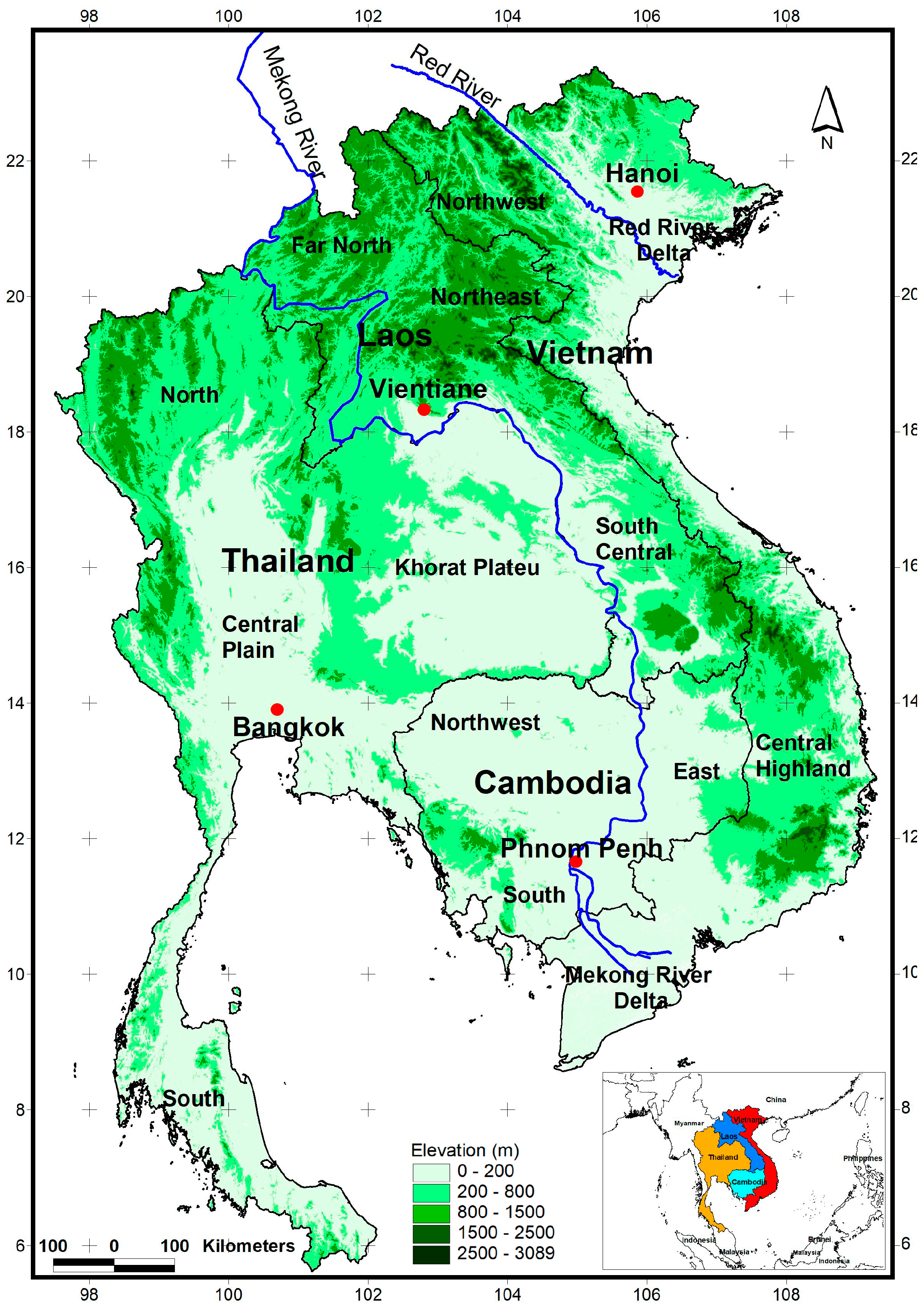

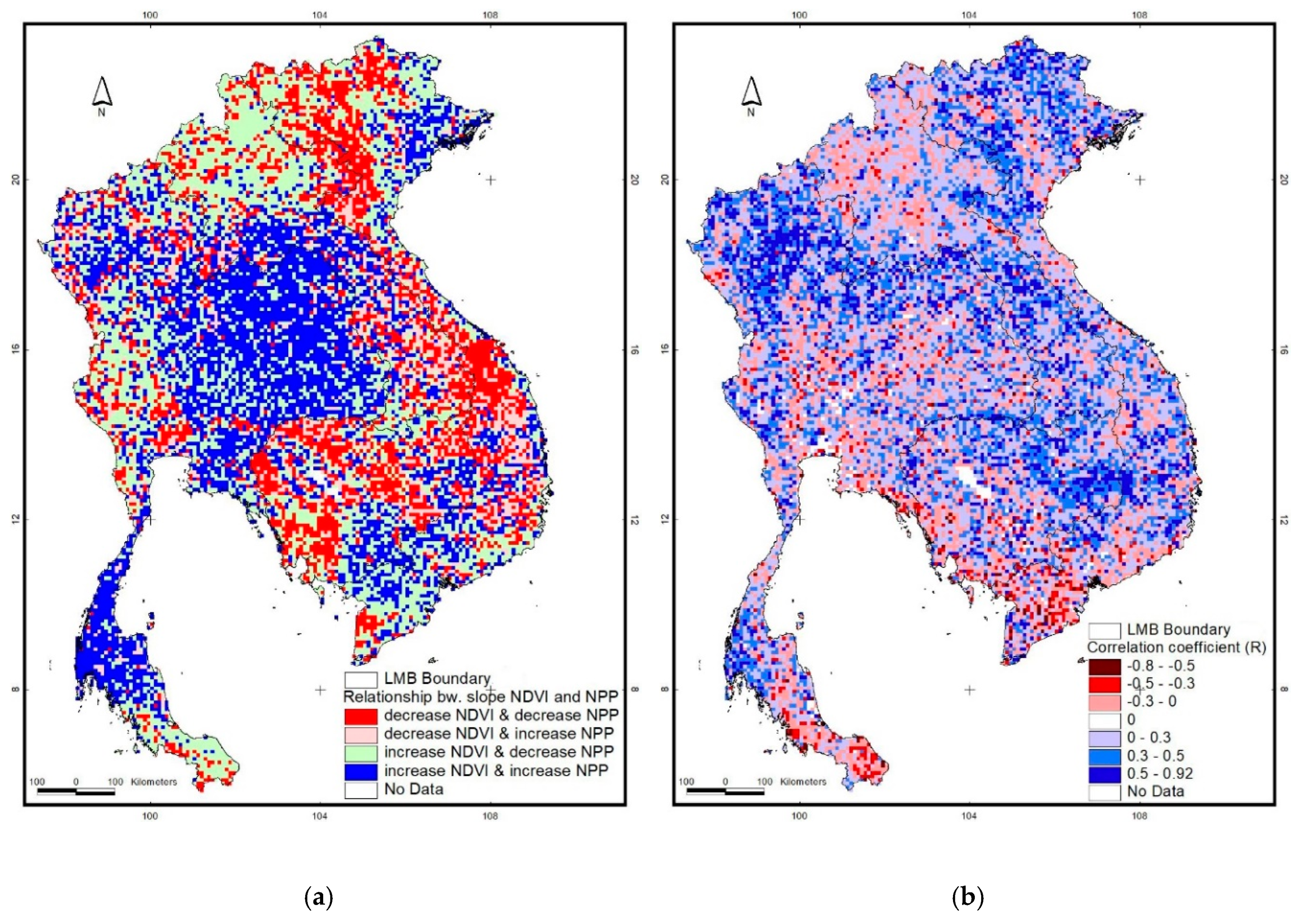
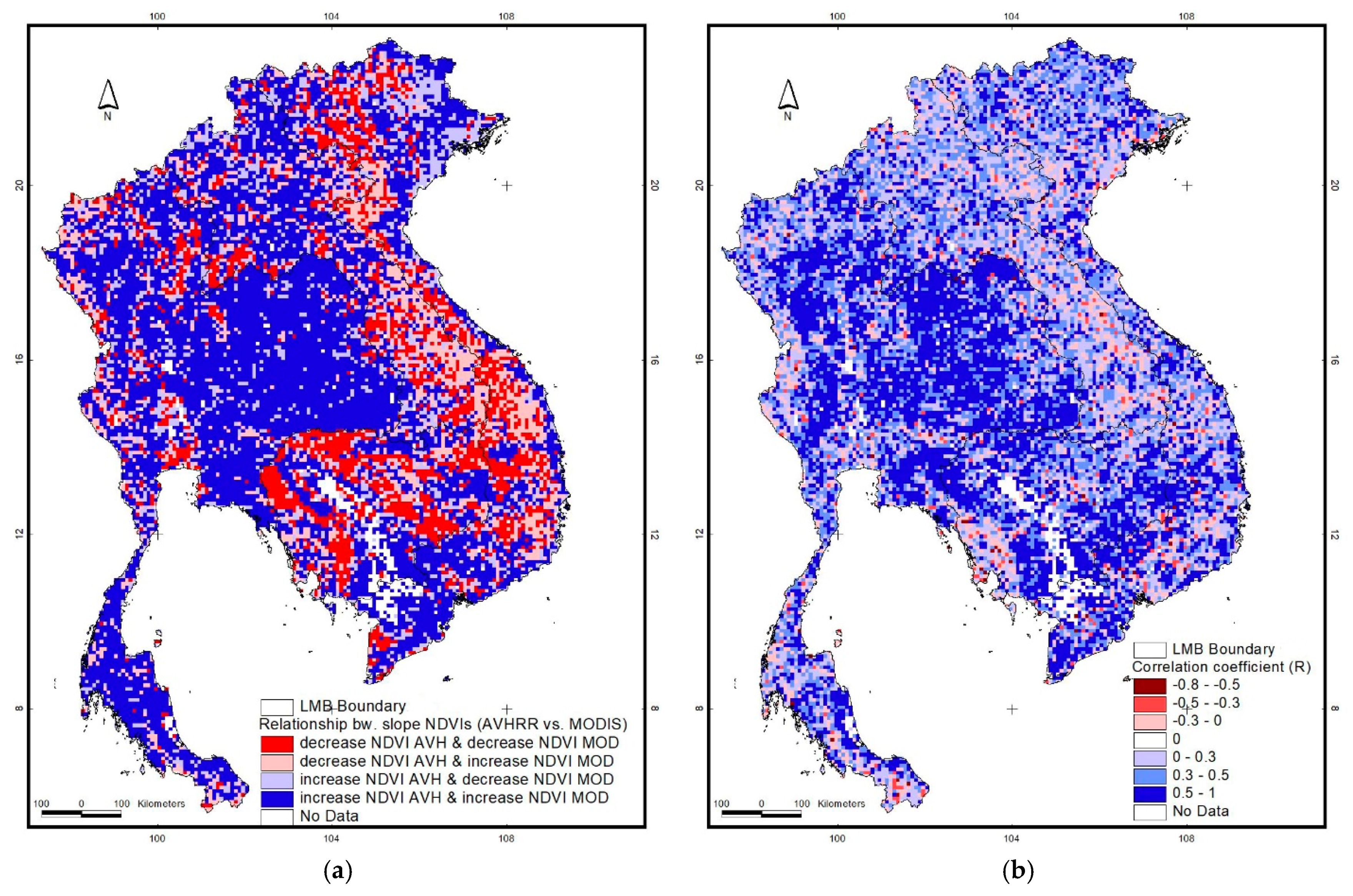
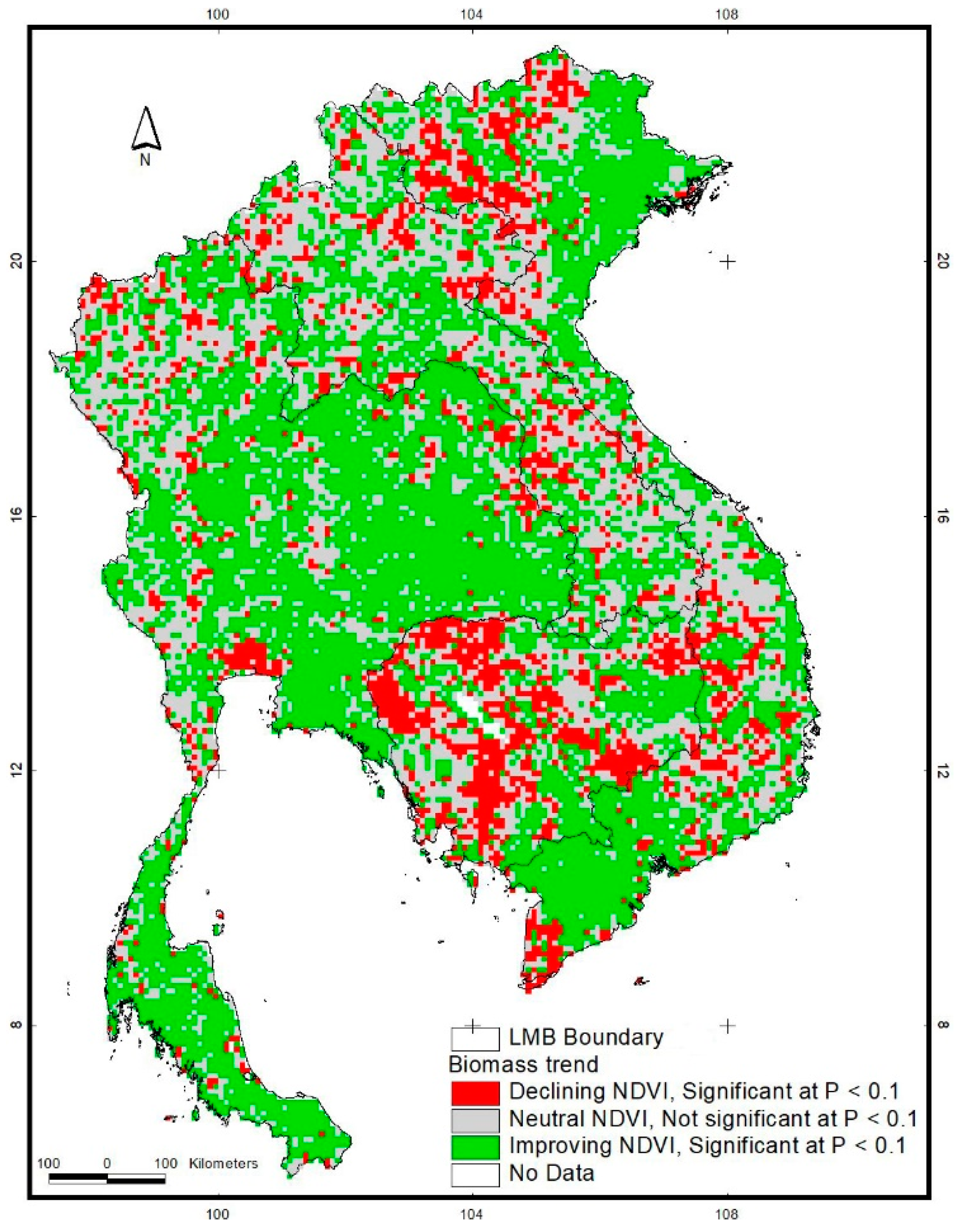
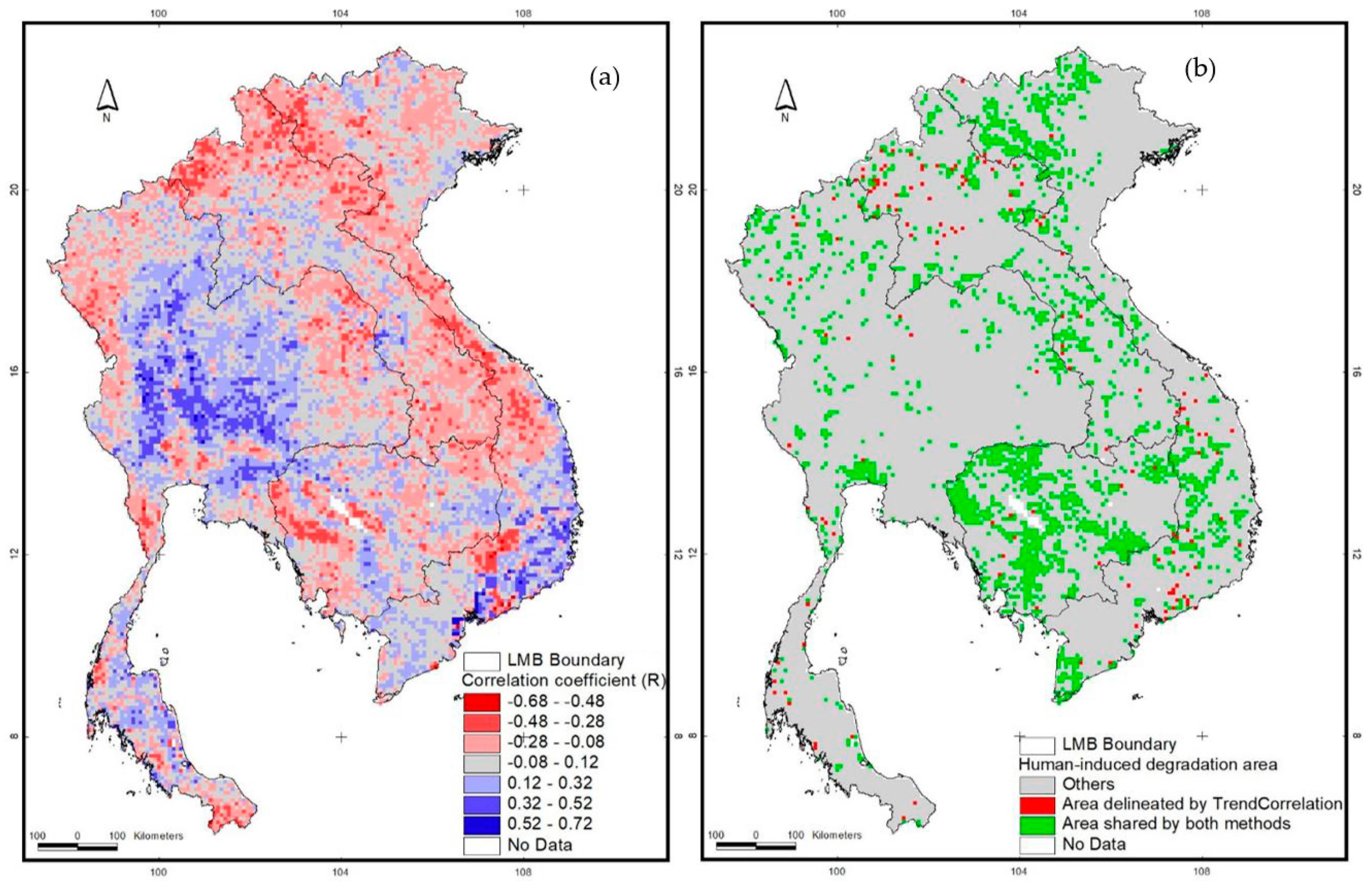

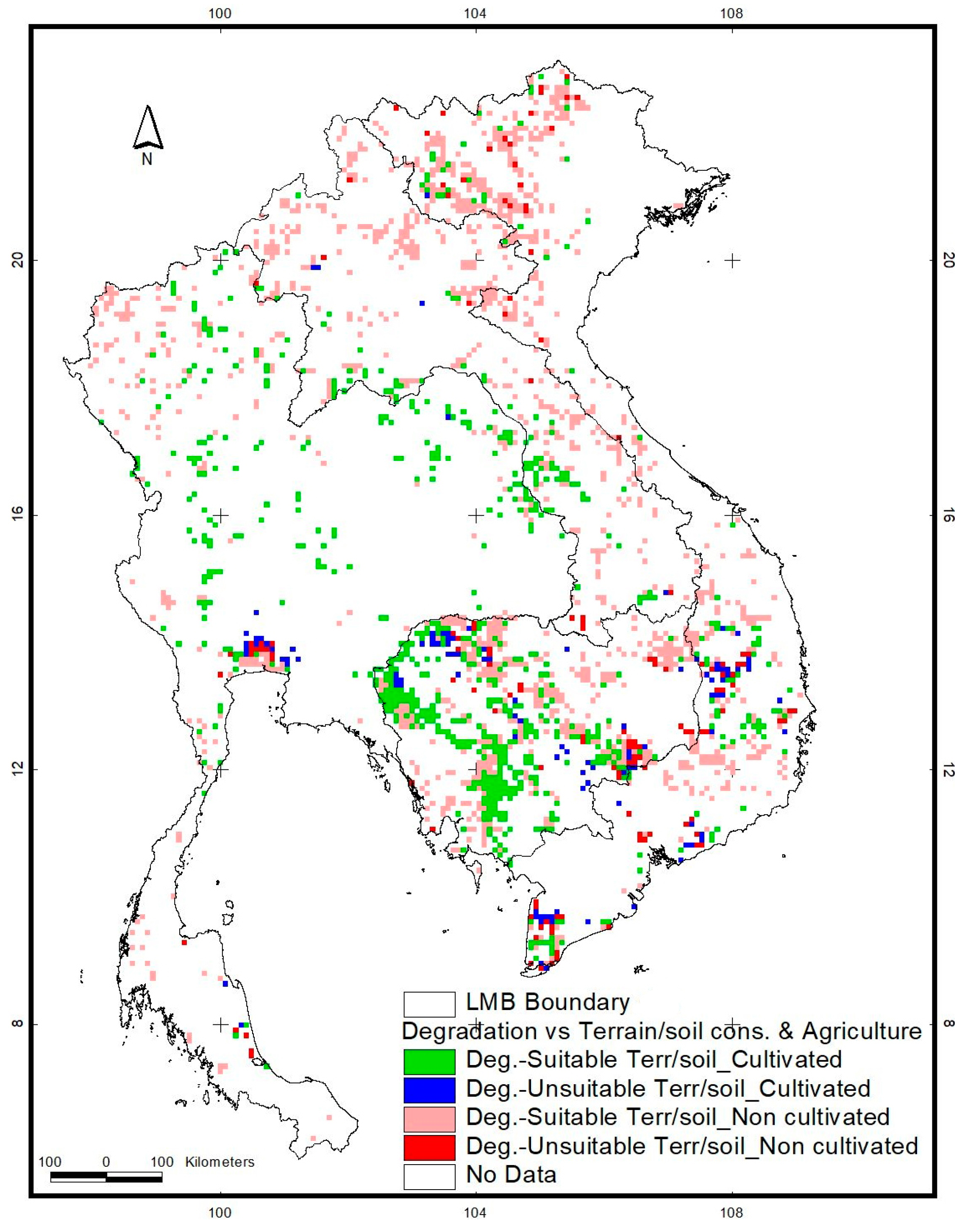
| Data downloaded | Spatial resolution | Temporal resolution | Source | Access date |
|---|---|---|---|---|
| GIMMS AVHRR NDVI (NDVI3g.v1) [72] | 1/12 degree (approximately 9.16 km), global | Biweekly, 1982–2015 | Global Inventory Monitoring and Modeling System (GIMMS) (https://ecocast.arc.nasa.gov/data/pub/gimms/) | 30 April 2017 |
| MODIS NDVI Monthly L3 (MOD13A3) [73] | 1 km, global | Monthly, 2000–2015 | Land Processes Distributed Active Archive Center (LPDAAC) (https://lpdaac.usgs.go) | 5 May 2017 |
| Terra/MODIS NPP L4 (MOD17A3) [74] | Yearly, 2000–2014 | |||
| Gridded climate (temp. & rainfall) of the world (CRU TS V4) [75] | 0.5 degree (approximately 55 km), global | 1982–2015 | Climate Research Unit (CRU) at the University of East Anglia (http://www.cru.uea.ac.uk/) | 25 May 2017 |
| Updated Köppen-Geiger climate map [76] | 0.1 degree (approximately 11 km), global | 2007 | https://people.eng.unimelb.edu.au/mpeel/koppen.html | 15 August 2017 |
| Gridded Population of the World, Version 4 (GPWv4) [77] | 2.5 min (approximately 5 km), global | 2000, 2005, 2010, 2010, 2015 | Center for International Earth Science Information Network (CIESIN) at Columbia University (http://sedac.ciesin.columbia.edu/) | 15 Aug 2017 |
| SRTM Digital Elevation Database v4.1 [78,79] | 3-arc seconds (approximately 90 m at the equator), global | 2003 | CGIAR Consortium for Spatial Information (CSI) (http://www.cgiar-csi.org/data/srtm-90m-digital-elevation-database-v4-1#download) | 15 June 2017 |
| Soil constraints [80] | 5 arc-minute (approximately 10 km), global | 2002 | The International Institute for Applied Systems Analysis (IIASA) and the Food and Agriculture Organization (FAO) of the United Nations (http://www.iiasa.ac.at/Research/LUC/SAEZ/index.html) | |
| Land cover map from the Land Cover Portal of SERVIR Mekong | 1 km, LMB countries | Yearly, 2000–2015 | SERVIR Mekong (https://rlcms-servir.adpc.net/en/landcover) | 20 August 2017 |
| Country | % of Country’s Area | |
|---|---|---|
| This study | Shrestha and Roy (2008) * | |
| Laos | 13.7 | 18.2 |
| Thailand | 7.4 | 18.7 |
| Vietnam | 16.9 | 17.9 |
| Cambodia | 32.6 | 10.7 |
| Degradation Class by Climate Zone and Population Density | Soil/Terrain Constraint (km2) * | |||
|---|---|---|---|---|
| Total Area ** | No/Slight | Moderate | Severe/Very Severe | |
| Tropical monsoon | 34,356 | 11,172 | 19,824 | 3360 |
| Low density | 24,276 | 9408 | 14,364 | 504 |
| High density | 4956 | 1428 | 2856 | 672 |
| Very high density | 5124 | 336 | 2604 | 2184 |
| Tropical savanna | 116,928 | 32,844 | 68,964 | 15,120 |
| Low density | 107,016 | 31,248 | 63,924 | 11,844 |
| High density | 4200 | 1176 | 1596 | 1428 |
| Very high density | 5712 | 420 | 3444 | 1848 |
| Humid subtropical | 29,904 | 4116 | 23,688 | 2100 |
| Low density | 22,848 | 1848 | 19,488 | 1512 |
| High density | 5628 | 1428 | 3612 | 588 |
| Very high density | 1428 | 840 | 588 | 0 |
| Total | 181,188 | 48,132 | 112,476 | 20,580 |
| Degradation Class by Climate Zone and Soil/Terrain Constraint | Area of Land Cover (km2) | ||||||
|---|---|---|---|---|---|---|---|
| Total | Man-Grove | Decid-Uous Forest | Ever-Green Broad-Leaf | Mixed Ever-Green and Decid-Uous | Crop-Land | Other | |
| Tropical monsoon | |||||||
| No/slight constraint | 11,172 | 84 | 1932 | 1680 | 3276 | 3612 | 588 |
| Moderate constraint | 19,824 | 84 | 2940 | 4704 | 2184 | 8820 | 1092 |
| Severe/very severe constraint | 3444 | 588 | 168 | 0 | 168 | 1260 | 1260 |
| Tropical savanna | |||||||
| No/slight constraint | 32,844 | 0 | 5796 | 4200 | 7980 | 13,692 | 1176 |
| Moderate constraint | 68,964 | 252 | 17,976 | 7728 | 12,348 | 27,720 | 2940 |
| Severe/very severe constraint | 15,120 | 84 | 2436 | 672 | 2856 | 7644 | 1428 |
| Humid subtropical | |||||||
| No/slight constraint | 4116 | 0 | 756 | 336 | 2352 | 588 | 84 |
| Moderate constraint | 23,688 | 0 | 16,464 | 168 | 4704 | 1932 | 420 |
| Severe/very severe constraint | 2100 | 0 | 1512 | 252 | 252 | 84 | 0 |
| Total * | 181,272 | 1092 | 49,980 | 19,740 | 36,120 | 65,352 | 8988 |
© 2019 by the authors. Licensee MDPI, Basel, Switzerland. This article is an open access article distributed under the terms and conditions of the Creative Commons Attribution (CC BY) license (http://creativecommons.org/licenses/by/4.0/).
Share and Cite
Vu, Q.M.; Lakshmi, V.; Bolten, J. Assessment of the Biomass Productivity Decline in the Lower Mekong Basin. Remote Sens. 2019, 11, 2796. https://doi.org/10.3390/rs11232796
Vu QM, Lakshmi V, Bolten J. Assessment of the Biomass Productivity Decline in the Lower Mekong Basin. Remote Sensing. 2019; 11(23):2796. https://doi.org/10.3390/rs11232796
Chicago/Turabian StyleVu, Quyet Manh, Venkat Lakshmi, and John Bolten. 2019. "Assessment of the Biomass Productivity Decline in the Lower Mekong Basin" Remote Sensing 11, no. 23: 2796. https://doi.org/10.3390/rs11232796
APA StyleVu, Q. M., Lakshmi, V., & Bolten, J. (2019). Assessment of the Biomass Productivity Decline in the Lower Mekong Basin. Remote Sensing, 11(23), 2796. https://doi.org/10.3390/rs11232796




